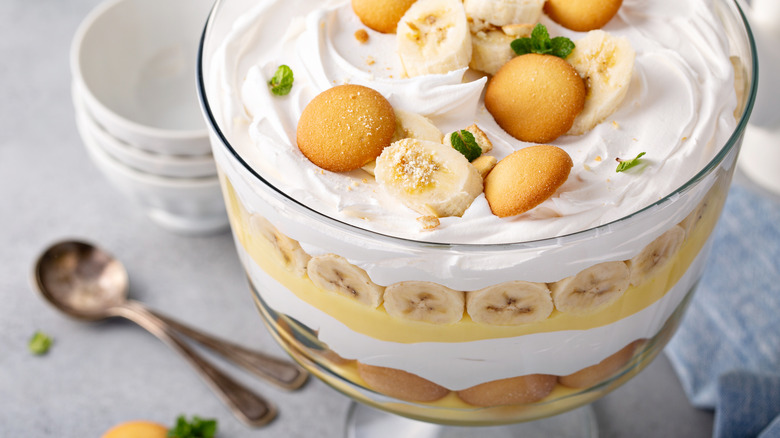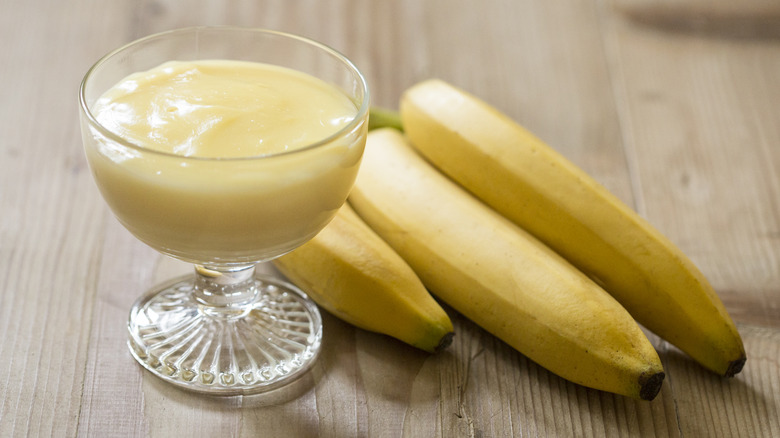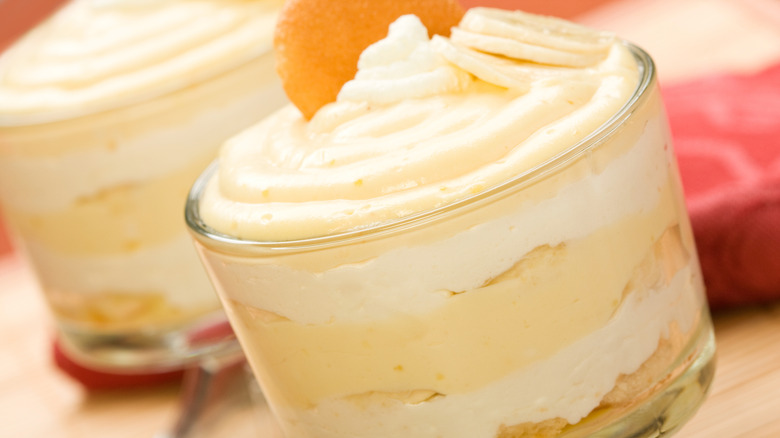The History Of Banana Pudding Is More Complex Than You'd Think
There's a surprising number of foods associated with the American South that don't originate from the region. Pimento cheese (despite often being referred to as "the caviar of the South") is originally from New York, while fried green tomatoes were likely invented by American Jews in the North or Midwest. This doesn't mean these foods are "stolen" or anything; they were just eventually adopted by another region far more so than by their place of origin. But it's also not the only time this has happened.
Banana pudding — not simply mashed bananas, but a mix of custard, bananas, and Nilla wafers — is often regarded as being as Southern as it gets; a staple on the level of fried chicken and hush puppies. But banana pudding's origins (muddled though they may be) pretty definitively don't point to the South. So where did it come from? There are two possible answers, depending on your perspective: Massachusetts or Illinois. And how did it become a classic Southern dish, considering neither of those places are anywhere near the South? The way a lot of foods did: Through the port of New Orleans.
New Orleans is responsible for banana pudding's Southern popularity
New Orleans is widely and justifiably regarded as the jewel in America's culinary crown, a wondrous fusion of different cuisines (Caribbean, African, Spanish, French, Native American, and even Chinese, Italian, Mexican, and Vietnamese — a surprising percentage of Earth's continents are represented here) that forms a greater whole, unlike any other food destination on the planet. It's a city that constantly adopts new food traditions and blends them with its own. And while the city didn't create banana pudding the same way it did étouffée, jambalaya, gumbo, and a host of other great dishes, they're definitely responsible for its association with the South.
Bananas are not a native crop to the American South; they come from Latin America and the Caribbean. Admittedly, that's not all that far of a journey — but it was a longer one before the advent of steamships. In the late 1800s, a whole host of crops became more widely available in the U.S. as overseas travel increased in both speed and cost-efficiency (and refrigeration wasn't that far behind). This was particularly true of anything growing in the countries directly to the South of the United States, and New Orleans was usually their first port of call. Bananas were among these, and eventually, access to the freshest bananas led to the rise of the dish throughout the entire region. But that's not where banana pudding itself was born.
Banana pudding originated around the turn of the century
There are a couple of possible origin points for banana pudding. First, it's important to note that the dish is basically a modified English trifle made with Nilla wafers instead of sponge cake. As for who thought to make that change, our first and best guess is the Northeast. There's a mention of banana pudding in an 1878 New York Times article, while the first actual recipe for something that looks a lot like banana pudding comes from an 1888 issue of "Good Housekeeping," a Massachusetts publication. So, at least the progenitors for banana pudding came from the North.
But the modern form of banana pudding — with the necessary inclusion of Nilla wafers — didn't actually arrive until later. In 1921, a printed recipe in the local Bloomington, Illinois newspaper by Laura Kerley became the first recorded use of Nilla wafers (at the time, "Vanilla wafers") in banana pudding instead of sponge cake. Apparently, Nabisco (the makers of the cookie) were paying attention because they went on what was, for the time, an all-out blitz, adding the recipe to the back of their cookie boxes and eventually cementing its association with Nilla wafers.
So, whether you credit the Northeast or the Midwest with modern banana pudding, you can't really credit the South. Still, the region embraced the dessert harder than anywhere else, and that's something.


